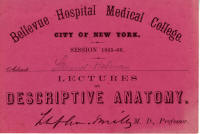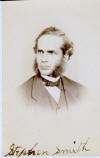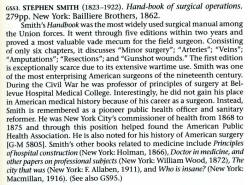Stephen Smith, M.D.

Click image to enlarge
Go to
Smith's lecture card display
Go to Smith's surgery book display
Name: Stephen Smith
Death date: Aug 26, 1922
Place of death: Montour Falls, NY
Birth date: 1823
Place of birth: Spafford, NY
Type of practice: Allopath
Practice specialities:PH Public Health, GS General Surgery, P
Psychiatry
Places and dates of practices:New York, NY, 1851, Oct 8, 1912, Oct
6, 1913, Nov 7, 1914, Sep 27, 1919, Nov 19, 1917, Nov 2, 1915, Dec
20, 1916, Skaneateles, NY, Jul 8, 1912, Sep 15, 1913, Jul 11, 1914,
Jul 13, 1915, Jun 14, 1919, May 23, 1917, Jul 2, 1916
Hospital affiliations: Bellevue Hospital, NY, 1891, St. Vincent's
Hospital, NY, Columbus Hospital, NY
Medical school(s): Columbia University College of Physicians and
Surgeons, New York, 1851, (G), NY-04 Geneva Medical College, Geneva:
Syracuse University College of Medicine, 1848
Other education: Public school
Professorship: Bellevue Hospital Medical College, New York, 1874,
surgery, anatomy
Journal of the American Medical Association Citation: 79:841; (M)
|
 SMITH, Stephen,
physician, born in Onondaga county, New York, 19 February, 1823. He was
educated in the public schools and at Cortland academy, Homer, New York,
and, after attending lectures at Geneva and Buffalo, New York, medical
college, was graduated at the New York college of physicians and
surgeons in 1S50, became a resident physician at Bellevue hospital, and
afterward settled in New York city. He became an attending surgeon to
Bellevue in 1854, was professor of surgery there in 1861-'5, and was
then transferred to the chair of anatomy. Since 1874 he has been
professor of clinical surgery in the medical department of the
University of New York. He became joint editor with Dr. Samuel S. Purple
of the "New York Medical Journal" in 1853, its sole editor in 1857,
changed it into a weekly and published it under the name of the "
Medical Times," in 1860, and continued in its charge until 1863, when
the paper was discontinued. He was among the first to propose the
organization of Bellevue medical college, and was a member of its
faculty for ten years, and it was mainly due to his efforts that the
Medical journal library was established. He made a thorough examination
of the sanitary condition of New York in 1865, and presented to the
legislature an official report of his investigations, which was
published (New York, 1865). He was appointed by the governor a health
commissioner in 1868, :and reappointed by the mayor in 1870 and in 1872,
was chiefly instrumental in founding the American health association in
that year, and was its president for four terms, He was also active in
organizing a National board of health, of which he was appointed a
member by the president in 1879. In 1882-'8 he was state commissioner of
lunacy, during which service he published six voluminous reports on the
condition of the insane, and of the institutions for their cure. Since
1880 he has been a member of the State board of charities. He has tied
the common iliac artery for aneurism, and was the second in this country
to perform Symes's amputation at the ankle-joint. He is a member of
various medical societies, and has published "Monograph of Seventy-five
Cases of Rupture of the Urinary Bladder," which was highly commended in
this country and abroad (1851), "Hand-Book of Surgical Operations"
(1863), and " Principles of Operative Surgery" (1879). SMITH, Stephen,
physician, born in Onondaga county, New York, 19 February, 1823. He was
educated in the public schools and at Cortland academy, Homer, New York,
and, after attending lectures at Geneva and Buffalo, New York, medical
college, was graduated at the New York college of physicians and
surgeons in 1S50, became a resident physician at Bellevue hospital, and
afterward settled in New York city. He became an attending surgeon to
Bellevue in 1854, was professor of surgery there in 1861-'5, and was
then transferred to the chair of anatomy. Since 1874 he has been
professor of clinical surgery in the medical department of the
University of New York. He became joint editor with Dr. Samuel S. Purple
of the "New York Medical Journal" in 1853, its sole editor in 1857,
changed it into a weekly and published it under the name of the "
Medical Times," in 1860, and continued in its charge until 1863, when
the paper was discontinued. He was among the first to propose the
organization of Bellevue medical college, and was a member of its
faculty for ten years, and it was mainly due to his efforts that the
Medical journal library was established. He made a thorough examination
of the sanitary condition of New York in 1865, and presented to the
legislature an official report of his investigations, which was
published (New York, 1865). He was appointed by the governor a health
commissioner in 1868, :and reappointed by the mayor in 1870 and in 1872,
was chiefly instrumental in founding the American health association in
that year, and was its president for four terms, He was also active in
organizing a National board of health, of which he was appointed a
member by the president in 1879. In 1882-'8 he was state commissioner of
lunacy, during which service he published six voluminous reports on the
condition of the insane, and of the institutions for their cure. Since
1880 he has been a member of the State board of charities. He has tied
the common iliac artery for aneurism, and was the second in this country
to perform Symes's amputation at the ankle-joint. He is a member of
various medical societies, and has published "Monograph of Seventy-five
Cases of Rupture of the Urinary Bladder," which was highly commended in
this country and abroad (1851), "Hand-Book of Surgical Operations"
(1863), and " Principles of Operative Surgery" (1879).
Edited Appletons Encyclopedia, Copyright © 2001 VirtualologyTM

Information from Rutkow, History of Surgery, p. 45
STEPHEN SMITH, M. D.,
of New York.
One of the most famous of New York State's physicians, Dr. Stephen Smith,
died on August 26 in Montour Falls, near Elmira, at the home of his
daughter, Mrs. Walter C. Mason. Death was due to general debility, resulting
from advanced age, for Doctor Smith would have been 100 years old on the
19th of next February.
Stephen Smith was born on a farm in Onondaga County, New York. His father
was a cavalry officer in the Revolutionary War. His medical studies were
carried on at Geneva, New York, and later at Buffalo, under Dr. Frank
Hamilton. He completed his course at the College of Physicians and Surgeons,
Columbia University, from which he was graduated in 1850. and was soon
afterwards appointed to the medical staff of Bellevue Hospital, where he
remained in various capacities for a number of years. He served also in St.
Vincent and Columbus Hospitals, and was professor of surgery and anatomy at
Bellevue, and professor of clinical surgery at New York University. From
1853 to 1857 he was joint editor of the New York Journal of Medicine and
from the latter date to 1860, editor. From 1860 to 1864 he served as editor
of the New York Medical Times. He was the author of A Handbook of Surgical
Operations, published in 1861 ; Principles and Practices of Surgical
Operations, 1879 ; The Doctor in Medicine, Who Is Insane, and The City That
Was, an account of the shocking health conditions in New York before
sanitation became a science.
Probably the most important work of his life, however, was his service to
New York as an official, working for better hygiene and sanitation. In 1864
typhus fever was rampant in New York, and an epidemic of smallpox was
raging. In those days no attempts were made to quarantine or segregate cases
of infectious or contagious diseases, and conditions became so f right ful
that a great public uprising in the cause of hygiene took place, which
resulted in the formation of a Citizens' Association, with Peter Cooper as
head. This organization appointed a council of health and engaged physicians
to survey the city with a view to doing away with the horrible conditions of
filth, insanitation, and loathsome epidemics. Of this council Doctor Smith
was the stay and inspiration, and the report put out by him and his
colleagues would now seem incredible. After considering this report, the
Citizens' Association instructed Doctor Smith, in cooperation with one of
the city's ablest attorneys, to draw up a law creating a Metropolitan Health
Department. After much opposition on the part of political gangs and job
holders, and in the face of other obstacles, this law was passed at Albany,
and Dr. Smith was appointed by Governor Fenton Commissioner of the
Metropolitan Board of Health.
When the National Board of Health was instituted in 1879, President Hayes
made him one of the first members. In 1880 Doctor Smith drafted and secured
the passage of the bill creating the New York State Board of Health. He was
made a member of the New York State Board of Charities in 1881, an office he
resigned the following year in order to accept that of State Commissioner of
Lunacy. He remained in this office for six years and was the means of
bringing about great reforms in the care and treatment of the mentally
diseased. It was one of his cherished ideas that all the insane should
receive State care, and the law to that effect was proposed, and drafted by
him. This law was enacted in 1887. Governor Flower, in 1893, re- appointed
him to the State Board of Charities, and he was retained in this office by
Governor Black. In 1894 he was sent by President Cleveland to France as a
delegate to the Ninth International Sanitary Conference. It was through his
influence and efforts that the American Public Health Association was
founded in 1872, and he was its first president. Another one of Doctor
Smith's notable services to the medical profession was the introduction of
trained nurses into hospitals and into the work of caring for the sick in
general.
Doctor Smith was not only a man of exceptional intellectual and scientific
ability, he possessed also unusual physical health and vigor, coupled with a
rare charm of personality. His last public appearance was in June, when he
was awarded the degree of Doctor of Science by Columbia University. In the
preceding November he was guest of honor at the semicentennial celebration
of the American Public Health Association at a dinner at the Astor. Upon
this occasion he was presented with a gold medal in commemoration of his
numerous and valuable public services.
It is of great interest to recall that, at the time of Doctor Smith's
graduation, 1850. there did not exist anywhere in this country a single
organization for public health and sanitation. New York city was totally
devoid of hygienic measures of any kind, and had a death rate of more than
thirty-five to the thousand. Doctor Smith left it with one of the most
efficient sanitary systems in the world, and with a death rate of twelve or
thirteen, and in rare instances as low as eight.
Medical/Surgical History--Part II, Volume
II
Chapter VII.--Injuries Of The Pelvis.
Section II.--Foreign Bodies In The Bladder
"Private D. W. Davis. Co. L, 1st
Massachusetts Heavy Artillery, aged 24 years, was wounded at Spottsylvania,
May 19, 1864. Assistant Surgeon J. C. McKee, U. S. A., reported "a gunshot
wound of left ilium, ball penetrating neck of bladder."
Acting Assistant Surgeon Stephen Smith
also reports the case as a "gunshot wound through bladder,"
without comments."
CASE 1899.--Private H. Conrad, Co. H, 10th New York Cavalry, aged 44 years,
was wounded at the Wilderness, May 7, 1864, and sent from a Sixth Corps
field hospital to Douglas Hospital, Washington. On July 18th, he was
transferred to the hospital at Blackwell's Island.
Acting Assistant Surgeon Stephen Smith
reported: "Admitted July 20, 1864; gunshot fracture of lower extremity of
radius with resection of two inches; wound sloughy. Severe secondary
haemorrhage September 9th. September 10th, amputation two inches above elbow
joint; flaps of skin and circular section of muscles; at time of operation
hand and forearm tensely swollen and infiltrated; hand gangrenous; patient
weak from loss of blood; very much dejected and indifferent; refused food
and stimulants. Wound looked well for two weeks. General and great
emaciation ensued, with disintegration of the margin of the flaps. Result:
death from inanition, September 23, 1864. The autopsy revealed no morbid
appearances except great emaciation."
_________________
From Bellevue Hospital:
Smith, Stephen Surgical
Division, 1851, II.
A. M., honoris causa, Brown, 1878; M.
D., College of Physicians and Surgeons, 1850; Visiting Surgeon,
Bellevue Hospital, 1854-91 ; Charity
Hospital, 1854-60; St. Vincent's Hospital since 1876; Consulting
Surgeon, Bellevue Hospital, 1892;
Professor of Principles of Surgery, Bellevue
Hospital Medical College, 1861-65; Lecturer on Anatomy, 1865-66;
Professor, 1866-72; Professor of Clinical Surgery, University of the
City of New-York, since 1874; Commissioner, New-York City Health
Department, 1868-72; Member, National Board of Health, since 1879; State
Board of Charities, 1881 ; New-York State Commissioner in Lunacy,
1882-87. Editor, "New-York Journal of Medicine," 1856-60; " American
Medical Times," 1860-64; " Hamilton on Fractures and Dislocations,"
1891. Author of " Hand-
book of Surgical Operations," Baillier Bros., 1862 ; "Manual of the
Principles and Practice of Operative Surgery," Houghton, Mifflin & Co.,
1882 ; " The Principles and Practice of Operative Surgery," Lea Bros. &
Co., 1887; "The Doctor in Medicine," 1872; "Annual Reports of the State
Commission in Lunacy," 1882-87. General Surgery: 574 Madison Avenue,
New-York City.
|
|